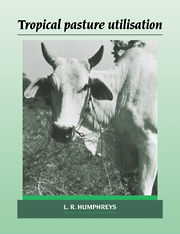Book contents
- Frontmatter
- Contents
- Acknowledgements
- List of abbreviations
- 1 Introduction
- 2 Pastures in tropical farming systems
- 3 Grazing and the environment for pasture growth
- 4 Effects of defoliation on the growth of tropical pastures
- 5 The modification of botanical composition by grazing: plant replacement and interference
- 6 The response of grazing animals to tropical pastures
- 7 Stocking rate and animal production
- 8 Continuity of forage supply: 1. The integration of different pastures
- 9 Continuity of forage supply: 2. Pasture conservation and supplementary feeding
- 10 Systems of rotational, deferred and mixed grazing
- 11 Conclusion
- References
- Index
10 - Systems of rotational, deferred and mixed grazing
Published online by Cambridge University Press: 23 September 2009
- Frontmatter
- Contents
- Acknowledgements
- List of abbreviations
- 1 Introduction
- 2 Pastures in tropical farming systems
- 3 Grazing and the environment for pasture growth
- 4 Effects of defoliation on the growth of tropical pastures
- 5 The modification of botanical composition by grazing: plant replacement and interference
- 6 The response of grazing animals to tropical pastures
- 7 Stocking rate and animal production
- 8 Continuity of forage supply: 1. The integration of different pastures
- 9 Continuity of forage supply: 2. Pasture conservation and supplementary feeding
- 10 Systems of rotational, deferred and mixed grazing
- 11 Conclusion
- References
- Index
Summary
Rotational and deferred grazing
(i) The number of animals grazed on the farm and the ways in which the farmer arranges a sequence of feeds to meet their physiological needs are the primary determinants of animal output and of the sustainability of the ecosystem. The question of the stocking method – how the animals are moved about the paddocks and the number of paddocks established on the farm – is quite secondary and usually unimportant for production. It does not receive much space in this book, but it is necessary to present some evidence which indicates the paucity of gains from investment in rotational grazing systems and the positive harm to the farm enterprise which they often occasion.
Some aspects of stocking method have already been discussed. The decrease in nutritive value due to ageing of pasture was described (Section 6.1.1) and this bears on rotational grazing, since more aged feed is presented to the animal than occurs in continuous grazing practice. The favourable effects of slashing and mowing on the leafiness of the pasture and structure are more than counterbalanced by the deleterious effects of reduced total leaf availability on animal performance (Section 6.2). The negative effects of night corralling and the loss of advantages due to curtailing animal selectivity in zero grazing or cut and remove systems were mentioned in Section 6.3, whilst problems of nutrient wastage and pollution associated with cut-and-remove systems received attention in Section 3.1.3.
- Type
- Chapter
- Information
- Tropical Pasture Utilisation , pp. 159 - 171Publisher: Cambridge University PressPrint publication year: 1991



